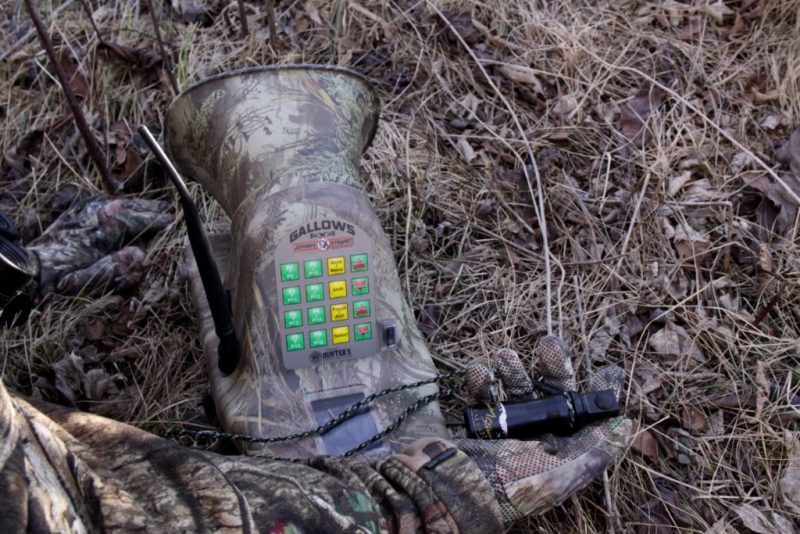Mix and Match Your Coyote Sounds
Mark Kayser 03.05.18

Are you using your electronic predator caller to its fullest potential? Modern electronic predator calls have large libraries with memory for thousands of sounds if you feel motivated to add them. Not only do you have a diverse selection of sounds at your fingertips, but you can mix and match those sounds as well.
Whether you stick strictly with an electronic mix or meld mouth calls with digital soundtracks, don’t overlook the benefit of a coyote blend to lure in cagey critters. What concoction should you consider?
Food Fight!
Coyote talk and prey top the list of the most commonly mixed calls. A simple cottontail-in-distress sound has proven effective for decades, but with the possibility of your peers using the same call, you should step it up with the sounds of a food fight.
Pick the prey of your choice and have that sound on standby. Now it’s your choice: You can either start the set with a series of lone howls and wait for several minutes, or go straight to a prey in peril. Using a howl first could instigate a territorial response from a nearby coyote, but it certainly tells nearby canines another coyote has crossed territorial boundaries.
After adding prey, wait again for several minutes to see if anything responds. If nothing enters the stage, then look for any coyote fighting or canine frenzy sounds, and add them. A short spat is enough to give any listening coyote the cue that there’s a fight over food in progress.
You can end the set there, or if you still hope to drag a coyote into view, then a challenge howl can end the set. I visualize it as a coyote telling the loser to leave and never come back.
Forty minutes into this exact scenario I called a mature female to within 150 yards for a slam-dunk Hornady ending on a recent hunt.

Curiosity Killer
Appealing to a coyote’s hunger pains has merit, but you can step it up a notch by building on a coyote’s curiosity simultaneously. The best way to add more enticement is to call upon other scavengers, specifically aerial groupies. That classification includes ravens, crows, magpies, jays and others. Build up that curiosity appeal by adding the sounds of these scavengers to a prey’s last breaths.
In addition to hopefully attracting a coyote, be ready to attract masses of whatever groupie you imitate. Nearly every aerial scavenger will respond when they hear the excitement in the wind of fellow foragers. That means increased camouflage and staying motionless on your part. Crows and the like have excellent eyesight. If they spy a ruse — you — then they’ll sound the alarm and vamoose.
Camouflage everything and refrain from moving. The more winged scroungers you attract, the more curiosity you manufacture. Increasing sight and sound sends resonating messages of excitement across the landscape. That’s your goal. Intermix prey and scavengers to prod an area coyote.
Much of the public land I hunt gets hit by numerous predator hunters on weekend-warrior duty. Instead of going with traditional prey sounds I’ll oftentimes simply sit for up to an hour calling magpies to my location with magpie chatter. Several times I’ve been one coyote heavy on the way back to the trailhead.
Love and Lust
Nobody wants to be lonely. Coyotes sometimes live a solo lifestyle, but most of the time they are in the company of littermates, pack members or a mate. If they do find themselves alone, then you can bet by February they are on the hunt for a mate with breeding season in full swing.
You don’t have to get fancy if trying to seduce a lone coyote into meeting during February or March. Lone, high-pitched howls mimic a female or even an adolescent coyote hoping to find a Match.com date. If nothing shows after a 30-minute wait, then you can mix it up a bit. Add in the vocalizations of a female inviting a male suitor to the bedroom.
Search your electronic call for coyote sounds such as the estrus whine, whimpers and yips. A female will advertise beyond the lone howl with these sounds of willingness. The addition of yips into the mix broadcasts that actual breeding may be taking place, and playful yips signal the foreplay.
Using sounds like this require a longer wait. An hour isn’t too long to patiently scan your setup site for a lovebird to show. During late winter, I often stick to howling with some casual estrus sounds intermixed to tag out on coyotes.
Howl Harmonization
Finally, mix different howls to sound like more than one coyote. There’s no need to sound angry or defensive. You simply want any nearby coyotes to wonder if a new neighbor is moving onto the block. Group howls or lone howls have equal footing, but if you feel the coyotes are already timid, then go with a lone howl.
How do you mix and match? In thick or broken country, howl at one site and then move aggressively forward to a better setup site giving you an elevated vantage point. Now howl again using a different tone or call selection. This mix makes it sound like two coyotes are talking to each other, plus it boosts a coyote’s confidence since the sounds came from different locations.
If nothing appears after 30 minutes, then add in crows, prey distress or even coyote bickering. The move alone should be the incentive for another coyote in close proximity to investigate, but it never hurts to add incentive for late-season coyotes. Mix up your calls and you’ll incentivize every outing.


